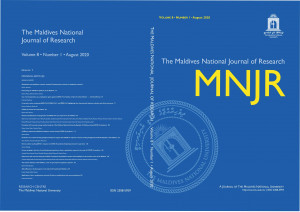Abstract
Food additives play a huge role in food safety and development of various food products. Stabilizers are one of the food additives which help in increasing the stability as well as the viscosity of the food products. Stabilizers are found in almost all of the dairy products, desserts and many beverages. In addition, food colours are added to different types of foods to increase shelf life, visual attractiveness and to compensate for natural colour variations. Food dyes utilized in colouring mostly come from natural or artificial sources. The objectives of this study were to produce coconut ice cream using agar-agar stabilizer, conduct a sensory evaluation by a panel of 20 people using Likert scale to see the acceptability of the ice cream. Parameters like melting time and the presence of air bubbles were observed after freezing of the ice cream. Based on the sensory evaluation, for the overall acceptance of the ice cream a score of 9 was given. The results showed that it had a melt run of 130s/g and many air bubbles were formed before and after freezing. In the second part, a traditional Maldivian sweet known as “Ulhaali”was produced by adding beetroot extract into its key ingredient coconut honey or “Dhiyaa hakuru”, and ran a sensory evaluation of the product by a group of 15 participants, in terms of colour, aroma and taste, in order to draw a conclusion regarding the acceptability of the addition of the natural food colourant into the Maldivian sweet. Factors such as the colour retention was observed before and after frying. From the results obtained for the sensory evaluation, the product was highly accepted by the participants as all three descriptors received scores of 8.5 and above out of 10, and after addressing the limitations, the success of the study was rather high.
References
Aykın-Dinçer, E., Güngör, K., Çaglar, E., & Erbas, M. (2020). The use of beetroot extract and extract powder in sausages as natural food colourant. International Journal of Food Engineering, 17(1), 75-82. doi: 10.1515/ijfe-2019-0052
Carocho, M., Morales, P., & Ferreira, I. (2017). Sweeteners as food additives in the XXI century: A review of what is known, and what is to come. Food and Chemical Toxicology, 107, 302-317. doi: 10.1016/j.fct.2017.06.046
Chaudhary, S. (2020). Colouring of food by the use of natural colour extracted by beetroot (Beta Vulgaris), betalain pigment. Sustainability, Agri, Food And Environmental Research, 9(1). doi: 10.7770/safer-v0n0-art2017
Clydesdale, F. M. (1993). Colour as a factor in food choice. Critical Reviews in Food Science and Nutrition. https://doi.org/10.1080/10408399309527614
Dias, S., Pereira, D. M., Castanheira, E. M. S., Fortes, A. G., Pereira, R., & Gonçalves, and M. S. T. (2019). Beetroot as a Source of Natural Dyes for Ham. Proceedings. https://doi.org/10.3390/ecsoc-23-06626
Frank, J. (2015). Beet as a Red Food Colour – Processing & Formulation Challenges. Retrieved from https://knowledge.ulprospector.com/2366/fbn-beet-red- food-colour-processing-formulation-challenges/
Gao, J., Brennan, M., Mason, S., & Brennan, C. (2017). Effects of sugar substitution with “Stevianna” on the sensory characteristics of muffins. Journal Of Food Quality, 2017, 1-11. doi: 10.1155/2017/8636043
Leonard, J. (2017). Is honey better for you than sugar? Medicalnewstoday,. Retrieved from https://www.medicalnewstoday.com/articles/317728
Priya, K., Gupta, D., & Srikanth, K. (2011). Natural sweeteners: A complete review. Journal of Pharmacy Research, 4(7), 2034-2039.Rodriguez-Amaya, D. B. (2016). Natural food pigments and colourants. Current Opinion in Food Science. https://doi.org/10.1016/j.cofs.2015.08.004
Saha, S. (2015). Honey-the natural sweetener become a promising alternative therapeutic: A review. South Indian Journal Of Biological Sciences, (2), 103. doi: 10.22205/sijbs/2015/v1/i2/100432
Sanggramasari, S. (2019). Effect of honey and stevia as sugar substitute on sensory evaluation of chiffon cake.Journal Of Business On Hospitality And Tourism, 5(1), 117. doi: 10.22334/jbhost.v5i1.134
Sharma, A., Amarnath, S., Thulasimani, M., & Ramaswamy, S. (2016). Artificial sweeteners as a sugar substitute: Are they really safe? Indian Journal Of Pharmacology, 48(3), 237. doi: 10.4103/0253-7613.182888
van der Wel, H., van der Heijden, A., & Peer, H. (1987). Sweeteners. Food Reviews International, 3(3), 193-268. doi: 10.1080/87559128709540815
